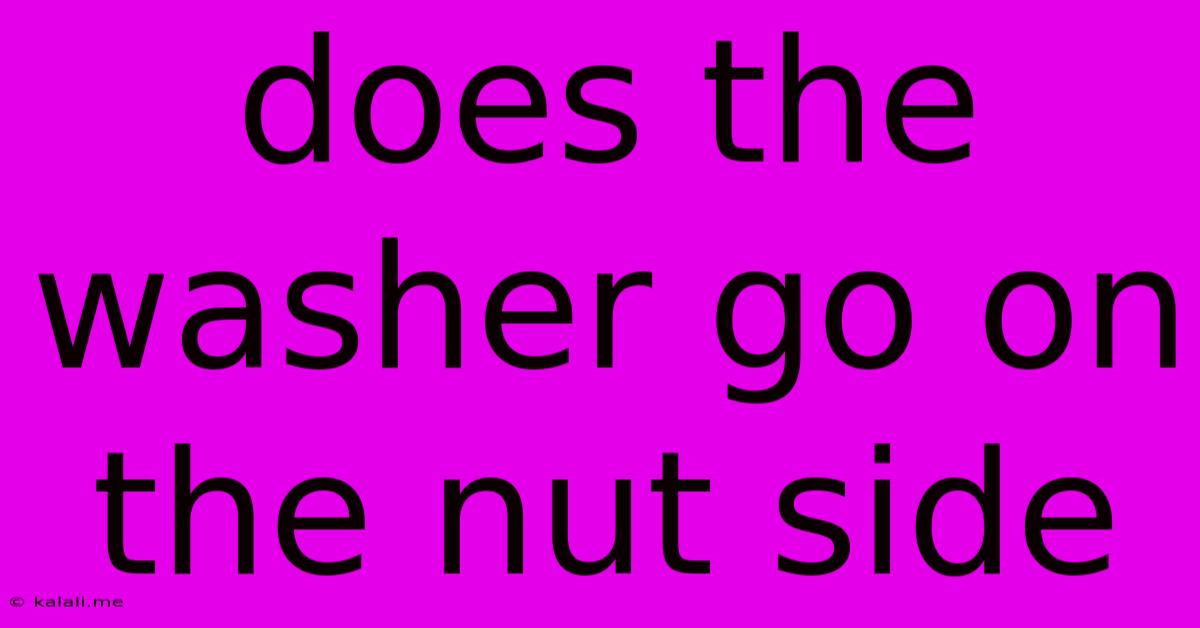Does The Washer Go On The Nut Side
Kalali
Jun 01, 2025 · 3 min read

Table of Contents
Does the Washer Go on the Nut Side or the Bolt Side? A Comprehensive Guide
This seemingly simple question, "Does the washer go on the nut side or the bolt side?", confuses many DIY enthusiasts and even experienced professionals. The truth is, there's no single universally correct answer. The best placement depends on several factors, including the type of washer, the application, and the materials involved. This guide will clarify when and why you might place a washer on the nut side, the bolt side, or even both.
Understanding Washers and Their Purpose
Washers are thin, flat rings of metal (or other materials) placed between a nut and a bolt head, or between a bolt head and a surface. Their primary purpose is to:
- Distribute the clamping force: Prevent the concentrated force of the fastener from damaging the material it's clamping to. This is crucial for preventing damage to softer materials like wood or plastic.
- Provide a better seal: In some cases, washers can act as a gasket, creating a watertight or airtight seal.
- Increase friction: Certain washers, such as lock washers, are designed to prevent loosening from vibration.
When to Place the Washer on the Nut Side
While many people instinctively place the washer under the bolt head, there are situations where placing it under the nut is more beneficial:
- Protecting the surface: If you're fastening into a delicate or easily damaged material, placing the washer under the nut protects the surface from being marred by the bolt head's edges. This is especially important with softer materials or when using a bolt head with sharp edges.
- Preventing rotation: In situations where the nut might rotate, placing the washer under the nut can help keep it from turning. This is more common in applications where the nut might spin freely under pressure.
- Using specific washer types: Some specialized washers, such as flanged washers, are specifically designed to sit under the nut, providing a larger bearing surface.
When to Place the Washer on the Bolt Side
The more common placement, putting the washer under the bolt head, is generally preferred when:
- The surface is strong and resistant to damage: If you're fastening into metal or another robust material, there's less risk of damage, making the bolt side placement sufficient.
- Using standard flat washers: Simple flat washers are generally equally effective under either the nut or the bolt. The slight difference in performance is negligible in most everyday applications.
- Ensuring proper bolt head seating: This ensures the bolt head sits flush against the surface, providing a clean and aesthetically pleasing finish.
When to Use Washers on Both Sides
Using washers on both the bolt and nut sides is sometimes recommended for:
- Increased clamping force distribution: This offers extra protection to the material being fastened.
- Applications requiring high vibration resistance: Using washers on both sides can enhance the stability of the fastener, particularly in high-vibration environments.
Conclusion: It Depends!
The question of whether the washer goes on the nut side or the bolt side doesn't have a definitive answer. The optimal placement depends entirely on the specific situation. Consider the materials involved, the type of washer being used, the level of vibration, and the overall application. By carefully considering these factors, you can ensure the most secure and damage-free fastening. If you're uncertain, err on the side of caution and consult a professional. Remember to always prioritize safety and proper installation techniques.
Latest Posts
Latest Posts
-
Integral From Negative Infinity To Infinity
Jun 03, 2025
-
Does Date Home Was Built Matter
Jun 03, 2025
-
Can You Put Brackets Inside Brackets
Jun 03, 2025
-
In The Or At The Office
Jun 03, 2025
-
The 24 V Is Dc Power Overcurrent
Jun 03, 2025
Related Post
Thank you for visiting our website which covers about Does The Washer Go On The Nut Side . We hope the information provided has been useful to you. Feel free to contact us if you have any questions or need further assistance. See you next time and don't miss to bookmark.